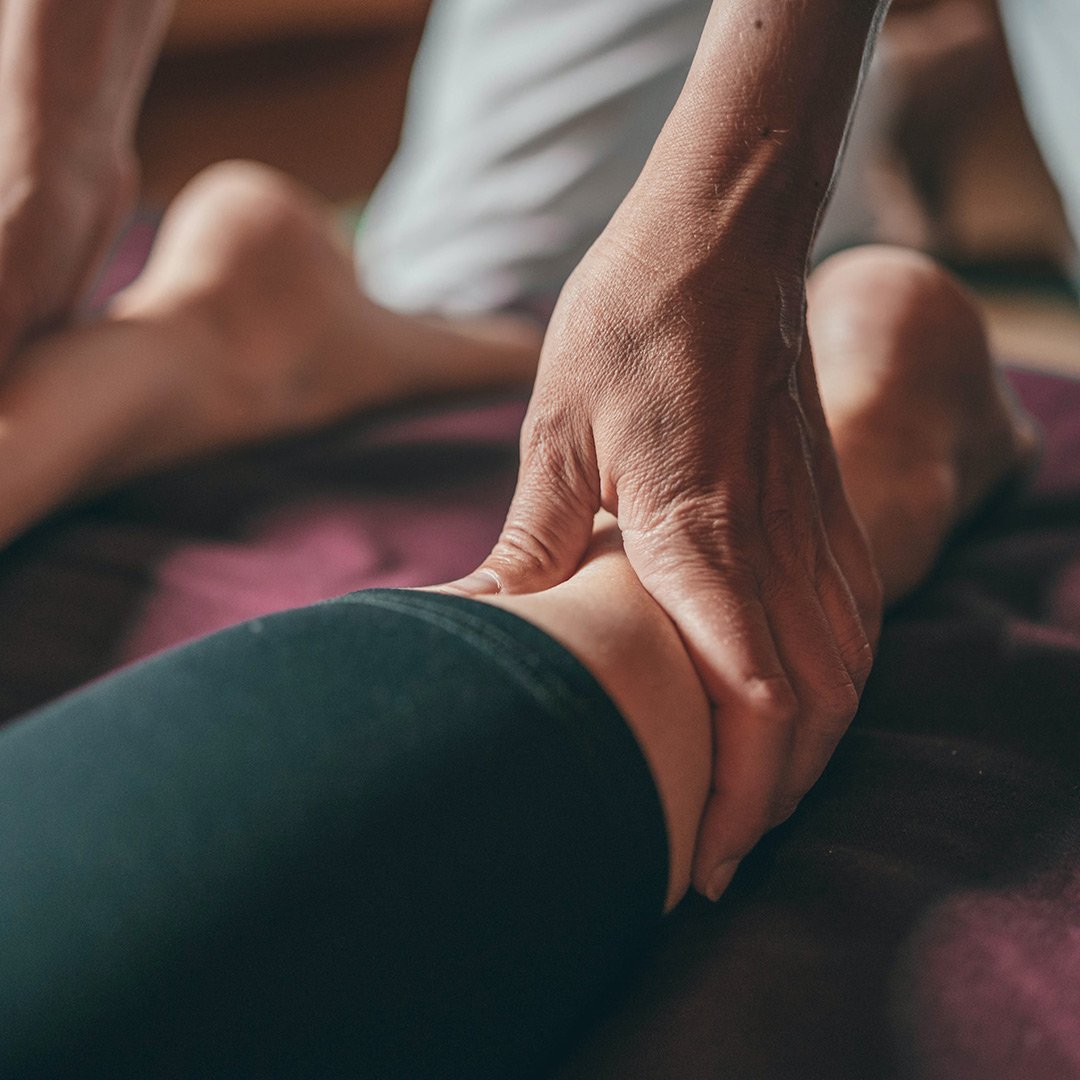
Key takeaways
- Aching legs can be a side-effect of chemotherapy drugs. For instance, 86% of those on taxanes experience it at some point during their treatment.
- Hot and cold therapy can relax the painful areas while relaxation techniques can help mentally. Massage and gentle movement are also recommended as a remedy for aching or heavy legs after chemotherapy.
- There are medicines you can take to ease pain, however, always check with your healthcare team before doing so and speak to them if your legs are continually aching.
The side-effects of chemotherapy differ in person-to-person. One physical impact which people can experience is aching legs, often setting in around two to three days after treatment. We spoke to Perci Professional and physiotherapist Hannah Leach about how physiotherapy and simple coping strategies can help with discomfort in your legs.
Chemotherapy can result in various physical side effects, including cramps and pain in the muscles (myalgia), joints (arthralgia) and bones (ostealgia). Pain may be mild and intermittent, or persistent and severe.
While the mechanism of this type of pain is not fully understood, a study by Asthana et al (2020) found that most people experiencing chemotherapy-induced pain describe it as “aching”, with words such as “burning” and “sharp” occasionally being used in the later stages of treatment. This suggests that there is initially an inflammatory component, occasionally followed by neuropathic (nerve) pain.
Particular chemotherapy drugs are more closely associated with ‘aching legs’; around 86% of those on taxanes experience joint or muscle pain (Fernandes et al, 2016, Smith et al, 2020). This is known as TAPS (Taxane Acute Pain Syndrome). The pain usually starts 2-3 days after receiving chemotherapy and can last up to 7 days in total.
Pain can have a potentially huge impact on a person’s ability to live their day-to-day life. If you are experiencing body or leg pain during chemo, it is firstly important to discuss this with your oncology team. They may wish to adjust your chemotherapy dose or take some tests to rule out other causes for your symptoms.
Chemo leg aches and pains usually resolve once your treatment has finished. So, what can be done in the meantime?
Consider the following remedies for aching legs after or during chemo that can help manage your pain, until your treatment has finished.
How to relieve joint and muscle pain after chemotherapy
Heat therapy
By applying a heat source to an area of pain, you are superficially increasing localised body temperature, dilating blood vessels and increasing blood flow to the area, to relax muscles. It can also stimulate thermoreceptors in the skin, overriding pain signals travelling to the brain with non-painful stimuli (known as ‘pain-gate theory’). You can use a hot water bottle, gel packs or hot baths.
Cold therapy
When a source of cold is applied to an area of the body, it constricts the blood vessels in the local area and reduces blood flow to the area. For this reason, the area will go numb and reduce your pain while the cold is applied. When the cold source is removed, blood flow to the area will increase thus ‘flushing’ away toxins from the area, which can help with inflammation. It can also reduce discomfort through pain-gate theory, as described above.
Massage

Receiving massage from a trained professional during your chemotherapy, may help manage symptoms of aching, pain, anxiety and restlessness. Light touch massage styles are recommended over deep muscle massages during cancer treatment. It is also recommended to avoid massage directly over tumour sites, affected lymphatic nodes and radiotherapy treatment sites. Trained massage therapists can be found through The General Council for Soft Tissue Therapies.
Gentle stretching programme
Muscles that are in pain tend to become tense. Over time this can lead to shortened, stiff muscles with a reduced range of movement. For this reason, it is important to incorporate gentle stretches into your daily routine, to maintain your movements and prevent further pain.
Regular activity
Your body was designed to move – though this may be easier said than done during chemotherapy treatment. Committing to a gentle exercise routine is hugely beneficial, for a vast number of chemotherapy-induced side-effects, including aching legs.
Choose a low-impact exercise that puts minimal stress through your joints, such as walking or using a static bike. Aim to complete for a short period daily where possible, to increase blood flow and maintain cardiovascular function. Find out more about the benefits of walking after chemo.
Medications
Your doctor will be able to give advice on pain relief, such as paracetamol, to help you cope with leg pain during your chemotherapy. Recent preliminary evidence (Smith et al, 2020) also suggests that the antihistamine loratadine may help reduce the severity of aching legs. You may wish to discuss this with your oncology team in case this is an option for you.
Relaxation techniques
While relaxation techniques may not directly address the cause of muscle aching, feeling confident using relaxation techniques to manage your pain can have a huge psycho-physiological benefit. Speaking to a psychologist or hypnotherapist with experience in cancer may help you to perfect these techniques for you to use regularly.
In summary, the top remedies for aching legs and joints are:
- Apply a heat source to the area of pain such as a hot water bottle or heat pack
- Take a warm bath to relax aching muscles
- Use a cold compress to numb pain and reduce inflamation
- Consider light touch massage to relieve pain
- Do gentle exercise and stretching such as walking to increase blood flow
- Practice relaxation techniques such as deep breathing or hypnotherapy
- Talk to your doctor about pain relief or antihistamines
Successfully managing the side-effects of chemotherapy will improve the quality of your treatment plan, your wellbeing and your life. If you are finding it difficult to manage your aching legs during chemotherapy, be sure to reach out to health-care professionals with the experience and expertise to support you.
If you would like personalised physiotherapy support, head to Hannah Leach’s Perci profile to book a one-to-one appointment.
Here at Perci Health, we are here to support anyone that has been impacted by cancer. If you think you or your loved one could benefit from virtual access to high-quality cancer specialists, find out more about our support types or how we help those living with cancer
While we have ensured that every article is medically reviewed and approved, information presented here is not intended to be a substitute for professional medical advice, diagnosis, or treatment. If you have any questions or concerns, please talk to one of our healthcare professionals or your primary healthcare team.
References
Asthana, R., Zhang, L., Wan, B.A. et al. “Pain descriptors of taxane acute pain syndrome (TAPS) in breast cancer patients—a prospective clinical study”. Support Care Cancer 28, 589–598. May 2019: https://doi.org/10.1007/s00520-019-04845-7
Fernandes R, Mazzarello S, Joy A, et al. “Taxane acute pain syndrome (TAPS) in patients receiving chemotherapy for breast or prostate cancer: a prospective multi-center study”. Support Care Cancer, 26, 3073–3081. Mar 2018: https://doi.org/10.1007/s00520-018-4161-x
Fernandes R, Mazzarello S, Hutton B, et al. “Taxane acute pain syndrome (TAPS) in patients receiving taxane-based chemotherapy for breast cancer—a systematic review”. Support Care Cancer, 24:3633-3650. Aug 2016: https://pubmed.ncbi.nlm.nih.gov/27146496/
Prieto-Callejero B, Rivera F, Fagundo-Rivera J, et al. “Relationship between chemotherapy-induced adverse reactions and health-related quality of life in patients with breast cancer”. Medicine, 99(33), e21695. Aug 2020: https://doi.org/10.1097/MD.0000000000021695
Smith C, Hendrickson A, Grudem M, Klampe C, Deering E and Jatoi A. “Loratadine for Paclitaxel-Induced Myalgias and Arthralgias”. American Journal of Hospice and Palliative Medicine®, 37(3):235-238. Mar 2020: https://mayoclinic.pure.elsevier.com/en/publications/loratadine-for-paclitaxel-induced-myalgias-and-arthralgias